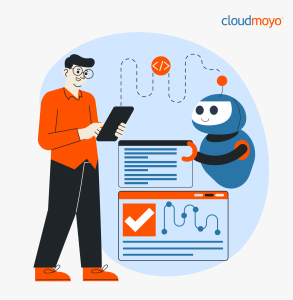ChatGPT, Bard, Copilot – do these sound familiar? In the last year since ChatGPT’s launch, artificial intelligence has made waves and headlines, transforming the way the everyday traverses life. Students can build essays, marketers can write headlines, a small business owner can make graphics, and developers can refine lines of code all at the touch of a button.
These examples refer to a specific type of artificial intelligence (AI) – generative AI.
Generative artificial intelligence “describes algorithms that can be used to create new content including audio, code, text, images, simulations, and videos” (McKinsey). It’s a new way to approach content generation that has both transformative benefits and uncharted consequences.
Generative AI currently uses machine learning – a way to develop artificial intelligence through data models that can “learn” from patterns without human direction. Machine learning, until recently, was limited to predictive modeling, meaning it could identify patterns like looking for trees in images. Now, it can build an image of a tree!
Building a generative AI language model is incredibly difficult because you need huge amounts of data to train the model before it can generate data for you. You need funding and the world’s best computer scientists and engineers to figure out how to build a language model like ChatGPT or DALL-E. But the potential use cases of AI for code are unbelievable, especially in the opportunities they present for businesses!
Use Case – Coding and Development
One of the most interesting use cases we’ve seen for generative AI is in coding. We all know how complicated and time-consuming writing lines of code is, and we know the frustration of writing code only for it to not work. These lines of code are the basis of so many things – iOS applications, Microsoft Word, Google Sheets, and your phone’s interface.
With generative AI, software development can be made much easier, especially for repetitive tasks. Research by McKinsey shows that tasks like code documentation, generation, and refactoring can be completed in significantly less time. However, when it came to more complex tasks, research found that time savings were less than 10%. Some areas where generative AI exceeded expectations:
- Expediting manual and repetitive work
- Jump-starting the first draft of new code
- Accelerating updates to existing code
- Increasing developers’ ability to tackle new challenges
The same research reveals where generative AI still needs human touch:
- Examining code for bugs and errors
- Contributing organizational context (specific needs of an organization or project)
- Navigating tricky coding requirements
When it comes to generative AI in software development and coding, developers should work alongside these tools and platforms for the most optimal outcomes. It allows developers to work on bigger, more meaningful problems while smaller tasks can be automated.
Use Case – Data Analytics and Data Management
When it comes to business intelligence and analytics, the tools in our arsenal for the last several years have been Excel, then BI tools, and then natural language processing (NLP) technology. All these still require data analysts or data literate folks who can structure the data, run reports, and then make sense of those reports. Even with advances like low-code/no-code, very few people in organizations use intelligence analytics tools not only due to a lack of literacy but also because vendor training is required to use these platforms.
With generative AI, the need to be data literate might be eliminated for many data users. Large language models (LLMs) (a type of AI that mimics human intelligence and uses statistical models to analyze vast amounts of data to learn patterns and connections between words and phrases) can now be applied to organizations’ data, opening data science and analytics to anyone who needs it.
This also frees data experts from responding to report requests as data becomes more accessible to the masses. Added time means data experts and analysts can spend their time working on more in-depth analysis of data.
Generative AI can also transform the way unstructured data becomes structured. According to TechTarget, “It can be programmed to automatically assign vectors to unstructured data as it gets ingested, potentially enabling enterprises to access vast troves of data now sitting untouched.” In layman’s terms, unstructured data is given meaning automatically – which is useful because an estimated 80% of data remains unstructured.
To summarize the above, here are the benefits of generative AI on business data analytics:
- Greater actionable insights generated and available to the masses
- Timesaving for analysts to focus on more in-depth analyses
- Eliminate the need for data literacy and vendor training for platforms
Is Your Data Secure?
While users at an individual or enterprise-level are quickly infusing generative AI to fast-track and automate tasks, it’s important to note that all language models work on the basic principle of consuming data, then generating data. As you feed confidential data to language models owned by various entities, it’s being consumed to train the language model and evolve over time. The most fool-proof way to protect your data is to keep it within the boundaries of your organization. This is where Microsoft’s Azure OpenAI comes into play. Microsoft provides the enterprise a promise of Azure, where you can be sure:
- Your data will not be used to train GPT models
- Your data will not be sent to OpenAI
Azure OpenAI rides on a foundation of enterprise security with all the highest security standards you expect from the cloud. You can depend on their security, where data is private and remains in your control. It also has the most recent language model GPT 4. ChatGPT is built on GPT 3.5.
To learn more about Azure OpenAI, click here.
Artificial Intelligence at CloudMoyo
One of CloudMoyo’s core pillars is to Infuse AI into Business Operations. We harness the power of AI/ML, unlock new efficiencies, eliminate labor-intensive tasks, and pave the way for game-changing innovation. Utilizing AI/ML, we offer predictive and prescriptive analytics services, predictive maintenance solutions, and NLP technology infused in our work.
The possibilities of AI are here, and we’re working closely with our partners to provide the best AI-driven solutions to all our customers.
As an Icertis partner, we’re excited about the launch of Icertis ExploreAI to bring the power of generative AI to enterprise contracting. Utilizing the power of LLMs and Icertis proprietary AI models, customers can derive insights from their contract data, enterprise data, and the Icertis Data Lake to deliver new, powerful, and material business outcomes.
With more than a decade of experience working alongside Microsoft and as a Microsoft Gold Partner, Azure OpenAI Services is a transformative launch for all, powering applications with large-scale generative AI models. Not only can this service support developers in code writing assistance and content generation, but it also has built-in responsible AI and enterprise-grade Azure security to detect and mitigate harmful use.
These tools are the future (and the future of artificial intelligence!) and CloudMoyo is ready to take on the challenge of making generative AI solutions more accessible to our customers. We want to drive efficiency at your organization, save you time and money, and help you transform with resilience.
Ready to get started? Contact us here >>














